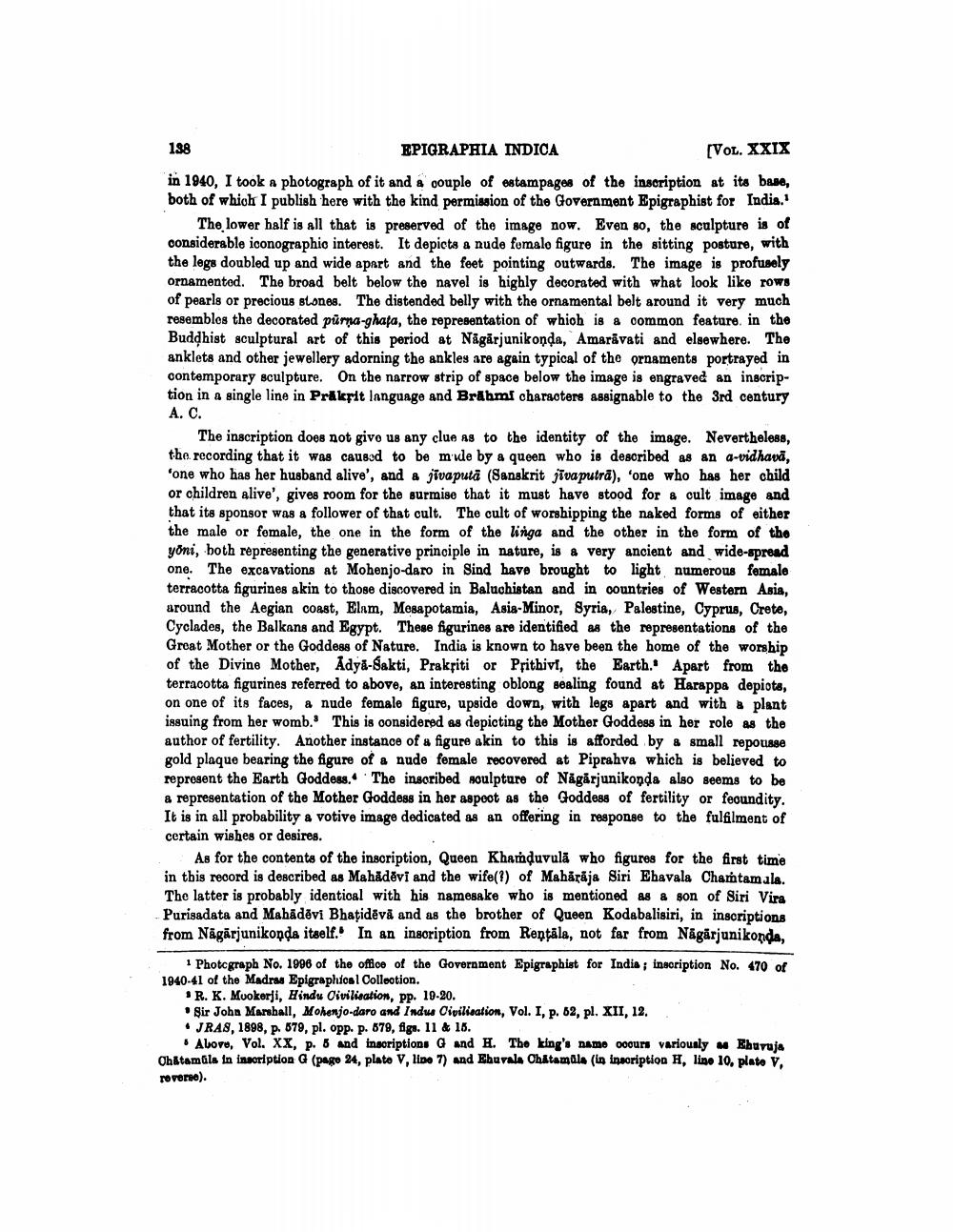________________
138
EPIGRAPHIA INDICA
[VOL. XXIX
in 1940, I took a photograph of it and a couple of estampages of the inscription at its base, both of which I publish here with the kind permission of the Government Epigraphist for India.'
The lower half is all that is preserved of the image now. Even so, the sculpture is of considerable iconographic interest. It depicts a nude fumalo figure in the sitting posture, with the legs doubled up and wide apart and the feet pointing outwards. The image is profusely ornamented. The broad belt below the navel is highly decorated with what look like rows of pearls or precious stones. The distended belly with the ornamental belt around it very much resembles the decorated pürna-ghafa, the representation of which is a common feature in the Buddhist sculptural art of this period at Nägārjunikonda, Amaravati and elsewhere. The anklets and other jewellery adorning the ankles are again typical of the ornaments portrayed in contemporary sculpture. On the narrow strip of space below the image is engraved an inscription in a single line in Prakerit language and Brahmi characters assignable to the 3rd century A. C.
The inscription does not give us any clue as to the identity of the image. Nevertheless, the recording that it was caused to be m e by a queen who is described as an a-vid havā, 'one who has her husband alive', and a jivaputā (Sanskrit jīva putra), 'one who has her child or children alive', gives room for the surmise that it must have stood for a cult image and that its sponsor was a follower of that cult. The cult of worshipping the naked forms of either the male or female, the one in the form of the linga and the other in the form of tho yoni, both representing the generative principle in nature, is a very ancient and wide-spread one. The excavations at Mohenjo-daro in Sind have brought to light numerous female terracotta figurines akin to those discovered in Baluchistan and in countries of Western Asia, around the Aegian coast, Elam, Mosapotamia, Asia-Minor, Syria, Palestine, Cyprus, Crete, Cyclades, the Balkans and Egypt. These figurines are identified as the representations of the Great Mother or the Goddess of Nature. India is known to have been the home of the worship of the Divine Mother, Adya-Sakti, Prakriti or Prithivi, the Earth. Apart from the terracotta figurines referred to above, an interesting oblong sealing found at Harappa depicts, on one of its faces, & nude female figure, upside down, with legs apart and with a plant issuing from her womb. This is considered as depicting the Mother Goddess in her role as the author of fertility. Another instance of a figure akin to this is afforded by a small repousse gold plaque bearing the figure of a nude female recovered at Piprahva which is believed to represent the Earth Goddess. The inscribed soulpture of Nagarjunikonda also seems to be & representation of the Mother Goddess in her aspoot as the Goddess of fertility or fecundity. It is in all probability a votive image dedicated as an offering in response to the fulfilment of certain wishes or desires.
As for the contents of the inscription, Queen Khamduvulā who figures for the first time in this record is described as Mahädėvi and the wife(?) of Mahārāja Siri Ehavala Chamtamala. The latter is probably identical with his namesake who is mentioned as a son of Siri Vira Purisadata and Mabädēvi Bhatidēvă and as the brother of Queen Kodabalisiri, in inscriptions from Nāgārjunikonda itself. In an inscription from Rentāla, not far from Nägārjunikonda,
1 Photograph No. 1996 of the office of the Government Epigraphist for India; inscription No. 470 of 1940-41 of the Madras Epigraphical Collection.
R. K. Muokerji, Hindu Civilisation, pp. 19-20. • Sir John Marshall, Mohenjo-daro and Indus Civilisation, Vol. I, p. 62, pl. XII, 12. • JRAS, 1898, p. 679, pl. opp. p. 679, figs. 11 & 16.
* Aloro, Vol. XX, p. 8 and inscriptions G and H. The king's namo ooours variously w Eburaja Oh&tamüla in inscription G (page 24, plate V, line 7) and Eburala Chatamala (in insoription H, lin. 10. plate v reverse).




